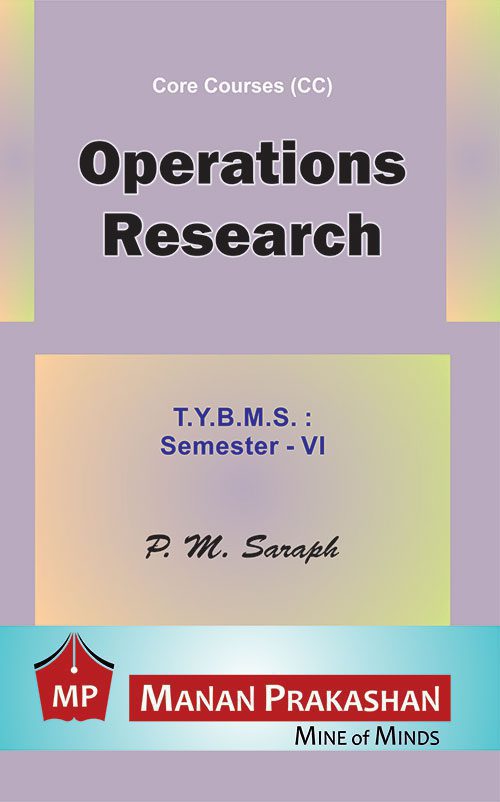Operation Research TYBMS Semester VI
Syllabus
1. Introduction to Operations Research and Linear Programming (15 Lectures)
(a) Introduction To Operations Research
Operations Research – Definition, Characteristics of OR, Models, OR Techniques, Areas of Application, Limitations of OR
(b) Linear Programming Problems: Introduction and Formulation
♦ Introduction to Linear Programming
♦ Applications of LP
♦ Components of LP
♦ Requirements for Formulation of LP Problem
♦ Assumptions Underlying Linear Programming
♦ Steps in Solving LP Problems
♦ LPP Formulation (Decision Variables, Objective Function, Constraints, Non Negativity Constraints)
(c) Linear Programming Problems : Graphical Method
♦ Maximization & Minimization Type Problems (Max. Z & Min. Z)
♦ Two Decision Variables and Maximum Three Constraints Problem
♦ Constraints can be “less than or equal to”, “greater than or equal to” or a combination of both the types i.e. Mixed Constraints
♦ Concepts : Feasible Region of Solution, Unbounded Solution, Redundant Constraint, Infeasible Solution, Alternative Optima
(d) Linear Programming Problems : Simplex Method
♦ Only Maximization Type Problems (Only Max. Z). No Minimization Problems (No Min. Z) Numericals on Degeneracy in Maximization Simplex Problems
♦ Two or Three Decision Variables and Maximum Three Constraints Problem (Up to Maximum Two Iterations)
♦ All Constraints to be “less than or equal to” Constraints (“Greater than or Equal to” Constraints not included)
♦ Concepts : Slack Variables, Surplus Variables, Artificial Variables, Duality, Product Mix and Profit, Feasible and Infeasible Solution, Unique or Alternate Optimal Solution, Degeneracy, Non-Degenerate, Shadow Prices of Resources, Scarce and Abundant Resources, Utilized and Unutilized Capacity of Resources, Percentage Utilization of Resources, Decision for Introduction of a New Product.
Note:
1. Surplus Variable, Artificial Variable and Duality to be covered only at Conceptual level for Theory Questions only and not included in Numerical.
2. Sensitivity Analysis including Profit Range and Capacity Range is not included.
2. Assignment and Transportation Models (15 Lectures)
(a) Assignment Problem – Hungarian Method
♦ Maximization & Minimization Type Problems
♦ Balanced and Unbalanced Problems
♦ Prohibited Assignment Problems, Unique or Multiple Optimal Solutions
♦ Simple Formulation of Assignment Problems
♦ Maximum 5 x 5 Matrix. Up to Maximum Two Iterations after Row and Column Minimization
Note :
1. Travelling Salesman Assignment Problem is not included.
(b) Transportation Problems
♦ Maximization & Minimization Type Problems
l Balanced and Unbalanced problems
♦ Prohibited Transportation Problems, Unique or Multiple Optimal Solutions
♦ Simple Formulation of Transportation Problems
♦ Initial Feasible Solution (IFS) by:
a. North West Corner Rule (NWCR)
b. Least Cost Method (LCM)
c. Vogel’s Approximation Method (VAM)
♦ Maximum 5 x 5 Transportation Matrix
♦ Finding Optimal Solution by Modified Distribution (MODI) Method. (u, v and D)
♦ Maximum Two Iterations (i.e. Maximum Two Loops) after IFS.
Note :
1. Production Scheduling Problem is not included.
2. Time Minimization Problem is not included.
3. Degeneracy Concept to be covered only at Conceptual Level. Not to be included in Numerical.
3. Network Analysis (15 Lectures)
(a) Critical Path Method (CPM)
♦ Concepts : Activity, Event, Network Diagram, Merge Event, Burst Event, Concurrent and Burst Activity
♦ Construction of a Network Diagram. Node Relationship and Precedence Relationship
♦ Principles of Constructing Network Diagram
♦ Use of Dummy Activity
♦ Numerical Consisting of Maximum Ten (10) Activities
♦ Critical Path, Sub-critical Path, Critical and Non-critical Activities, Project Completion Time
♦ Forward Pass and Backward Pass Methods
♦ Calculation of EST, EFT, LST, LFT, Head Event Slack, Tail Event Slack, Total Float, Free Float, Independent Float and Interfering Float
(b) Project Crashing
♦ Meaning of Project Crashing
♦ Concepts : Normal Time, Normal Cost, Crash Time, Crash Cost of Activities. Cost Slope of an Activity
♦ Costs involved in Project Crashing : Numericals with Direct, Indirect, Penalty, Crash Cost and Total Costs
♦ Time-Cost Trade off in Project Crashing
♦ Optimal (Minimum) Project Cost and Optimal Project Completion Time
♦ Process of Project Crashing
♦ Numerical Consisting of Maximum Ten (10) Activities
♦ Numerical based on Maximum Four (04) Iterations of Crashing
(c) Program Evaluation and Review Technique (PERT)
♦ Three Time Estimates of PERT : Optimistic Time (a), Most Likely Time (m) and Pessimistic Time (b).
♦ Expected Time (te) of an Activity Using Three Time Estimates
♦ Difference between CPM and PERT
♦ Numerical Consisting of Maximum Ten (10) Activities
♦ Construction of PERT Network using te values of all Activities
♦ Mean (Expected) Project Completion Time
♦ Standard Deviation and Variance of Activities
♦ Project Variance and Project Standard Deviation
♦ ‘Prob. Z’ Formula
♦ Standard Normal Probability Table. Calculation of Probability from the Probability Table using ‘Z’ Value and Simple Questions related to PERT Technique
♦ Meaning, Objectives, Importance, Scope, RORO/LASH
4. Job Sequencing and Theory of Games (15 Lectures)
(a) Job Sequencing Problem
♦ Processing Maximum 9 Jobs through Two Machines only
♦ Processing Maximum 6 Jobs through Three Machines only
♦ Calculations of Idle Time, Elapsed Time etc.
(b) Theory of Games
♦ Introduction
♦ Terminology of Game Theory : Players, Strategies, Play, Payoff, Payoff matrix, Maximin, Maximax, Saddle Point
♦ Types of Games
♦ Numericals based on :
– Two Person Zero Sum Games including strictly determinable and Fair Game
– Pure Strategy Games (Saddle Point available). Principles of Dominance Method
Additional Information
| BOARD | Mumbai University |
|---|---|
| ISBN-13 | 978-93-5750-160-6 |
| AUTHOR | Mrs. P M Saraph |
| PUBLISHER | Manan Prakashan |
| EDITION | All |
| PAGES | 248 |
| SUBJECT | Operation Research |
| LANGUAGE | English |


Reviews
There are no reviews yet.